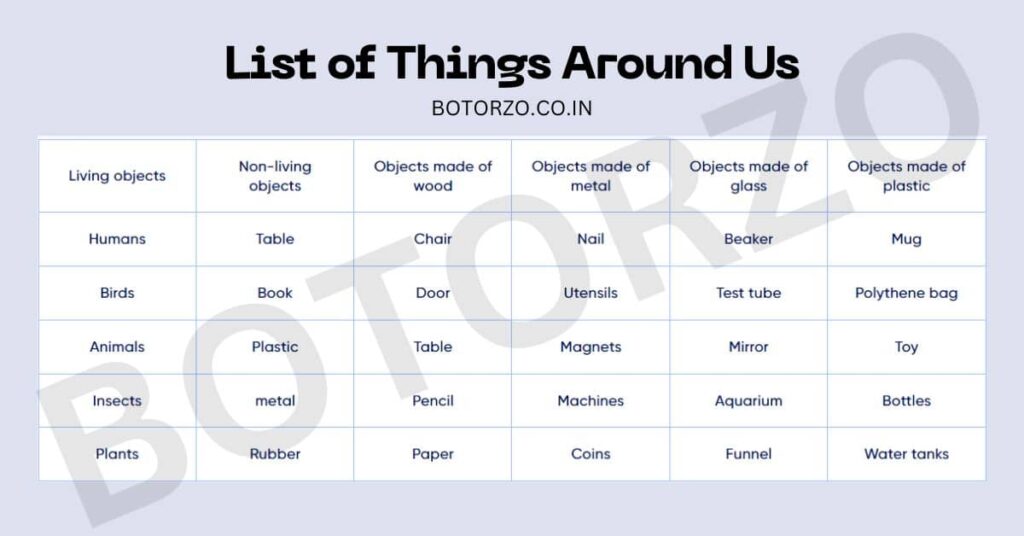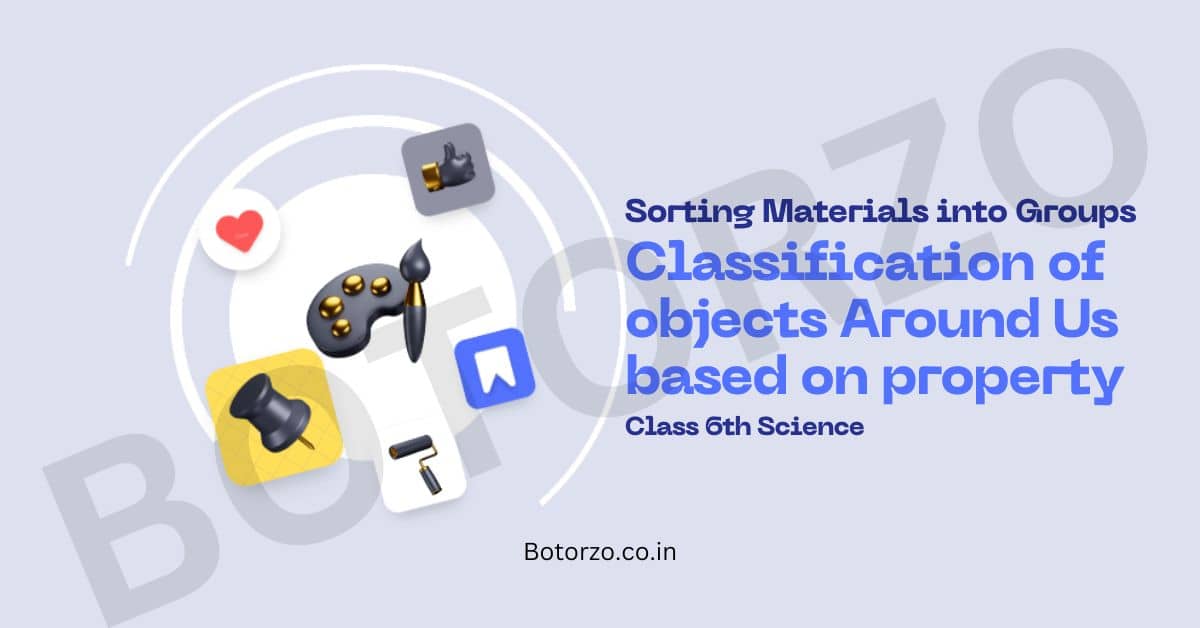Knowing the characteristics of various types of materials is necessary to categorise items according to their materials. A few of a substance’s features include its size, shape, colour, texture (hard or soft, smooth or rough), hardness, appearance, fragrance, transparency, etc.
In this article, we are going discuss the Classification Of Objects Around Us Based On Properties
As we turn around, there are so many various kinds of items all around us. Almost everything falls within this category, such as pens, pencils, fans, bags, televisions, and more. All of the things we see around us were created or discovered by us to achieve a certain goal or purpose.
We must be aware of the qualities of each of these items. These traits vary from one another, and how they are used largely relies on those differences. Because light is present and has certain characteristics, we can see the objects around us. We’ll also observe how these things are divided up into groups.
Read More
Significance of Objects Around Us
Importance Of Objects Around Us
What is Material?
Materials are substances or materials that are utilised to produce, create, or build something. They might be manufactured or natural, and are frequently classed according to their traits and qualities. Among other materials, common ones include metals, polymers, ceramics, glass, wood, and textiles.
The physical, chemical, and mechanical qualities of materials can affect how they are used and applied. For instance, metals are frequently utilised because to their durability, conductivity, and strength, but polymers are prized due to their low weight, flexibility, and moldability.
Materials play a crucial role in modern technology
Materials science is the study of how to create new products and technology by using their characteristics, makeup, and behaviour. Several academic fields, including physics, chemistry, engineering, and biology, are included in this area of research.
From building materials for construction to high-tech materials for electronics and aircraft, materials play a critical part in modern technology. New opportunities for innovation and design have been made possible by the creation of novel materials with distinctive qualities and features thanks to advancements in materials science.
List of Objects Around Us

classification of objects Around Us based on property

Objects around us can be classified based on their properties. Here are some common ways in which objects around us can be classified based on their properties:
- Material
- Shape
- Size
- Weight
- Texture
- Colour
- Function
- Age
- Origin
- State of matter
- Density
- Hardness
- Transparency
- Conductivity
- Magnetism
- Elasticity
- Flammability
- Acidity
- odour
- Durability
- Toxicity
- Reflectivity
Material
Materials used to make objects, such as wood, metal, plastic, glass, or cloth, can be used to categorise them.
Shape
Depending on the shape of an object, it can be categorised as spherical, cylindrical, rectangular, or irregular.
Size
Depending on an object’s size, it can be categorised as tiny, medium, or huge.
Weight
Depending on an object’s weight, it might be categorised as light, heavy, or medium.
Texture
Items can be categorised according to their texture, which can be described as rough, smooth, or soft.
Colour
Depending on the colour of an object, such as red, blue, green, or yellow, it can be classed.
Function
Items can be categorised according to their intended use, such as as tools, toys, furniture, or electronics.
Age
Items can be categorised as new, used, or antique depending on their age.
Origin
An object’s origin can be used to categorise it as either natural, manufactured, or imported.
State of matter
Whether an object is a solid, liquid, or gas depends on its state of matter. For instance, ice, water, and steam are all examples of solid, liquid, and gaseous objects, respectively.
Density
According to their density, which is defined as the amount of mass per unit volume, objects can be categorised. Higher densities make objects heavier and more svelte than lesser densities do.
Hardness
An object’s capacity to withstand being scraped or dented might be used to classify it. High-hardness objects are more resistant to harm than those of lesser hardness.
Transparency
The capacity of an object to permit light to flow through it may be used to categorise it. Transparent materials, like glass or water, let the passage of light; opaque materials, like wood or metal, do not.
Conductivity
The capacity of an object to conduct electricity or heat may be used to classify it. Good conductors, like metals, make it easy for electricity or heat to go through them, whereas weak conductors, like rubber or plastic, make it difficult.
Magnetism
The magnetic characteristics of objects can be used to classify them. Magnetic objects, such as iron or steel, are drawn to magnets, but non-magnetic items, such as plastic or wood, are not.
Elasticity
Things may be classed based on their elasticity, which is their capacity to stretch and return to their original shape. Things having high elasticity, such as rubber bands, may stretch a lot and return to their original shape, whereas objects with low elasticity, such as clay, can not stretch much and may not return to their original shape.
Flammability
Things are classed according to their flammability, or their ability to catch fire or burn. Very flammable items, such as petrol or paper, may quickly catch fire, whereas non-flammable things, such as rocks or glass, can not catch fire.
Acidity
Acidity is a measure of how acidic or basic a material is, and it may be used to classify objects. Acidic items, such as vinegar or lemon juice, have a low pH, whereas basic objects, such as baking soda or soap, have a high pH.
odour
Things can be classed depending on their odour, or the scent they generate. Things with a strong and distinct odour, such as perfumes or spices, have a distinct aroma, whereas those with no odour, such as water or glass, are odourless.
Durability
Items can be classed according to their capacity to endure wear and tear over time. Very durable materials, such as metals or stones, can survive for many years without breaking down or being damaged, whereas less durable objects, such as paper or plastic, may deteriorate fast over time.
Toxicity
Things are classed according to their toxicity, which is the extent to which they may affect living creatures. Very hazardous substances, such as some chemicals or poisons, can cause serious injury or even death, whereas less toxic objects, such as water or air, are typically harmless.
Reflectivity
Items may be classed based on their capacity to reflect light, which is measured in percentages. Highly reflecting things, such as mirrors or polished metals, reflect a lot of light, whereas less reflective objects, such as textiles or wood, absorb more light.
Read More
Component of food
Food variety
Frequently Asked Questions
Why do we classify objects around us?
To organize and understand them better.
How do we classify objects?
Objects can be classified based on a variety of properties, such as size, shape, color, texture, material, function, and location.
How does classifying objects help us in our daily lives?
It helps us with storage, purchasing decisions, and understanding how objects function and interact
How do scientists classify objects?
They use different classification systems depending on the objects and properties being studied.
Can objects belong to more than one classification?
Yes, objects can belong to more than one classification.
Has the classification of objects changed over time?
Yes, it has evolved as scientific knowledge has grown.
Are there cultural or societal factors that influence object classification?
Yes, cultural and societal factors can influence how we classify objects.
Our Sponsered Domain


1 thought on “Classification Of Objects Around Us Based On Properties”
Comments are closed.